Publications & Data
[Summary of the work] This study investigates how hydrological variability affects fish passage in fishways, focusing on the Iberian barbel (Luciobarbus bocagei). Laboratory and field studies assessed fish movement under different water conditions, revealing that hydrological changes significantly impact fish passage rates, timings, and size selection. Key factors influencing these metrics include maximum velocity and power dissipation. The findings highlight the importance of incorporating hydrological variability into fishway design and management, especially given the increasing climatic uncertainties, to effectively conserve fish in river ecosystems. The study advocates for adaptive management and comprehensive hydrodynamic research in fishway design.
Fuentes-Pérez, J. F., Bravo-Córdoba, F. J., García-Vega, A., Eckert, M., Branco, P., & Sanz-Ronda, F. J. (2024). Effect of hydrological variability on fishways and its implications in their management. Unde review.
Fuentes-Pérez, J. F., Bravo-Córdoba, F. J., García-Vega, A., Eckert, M., Branco, P., & Sanz-Ronda, F. J. (2024). Effect of hydrological variability on fishways and its implications in their management. Unde review.
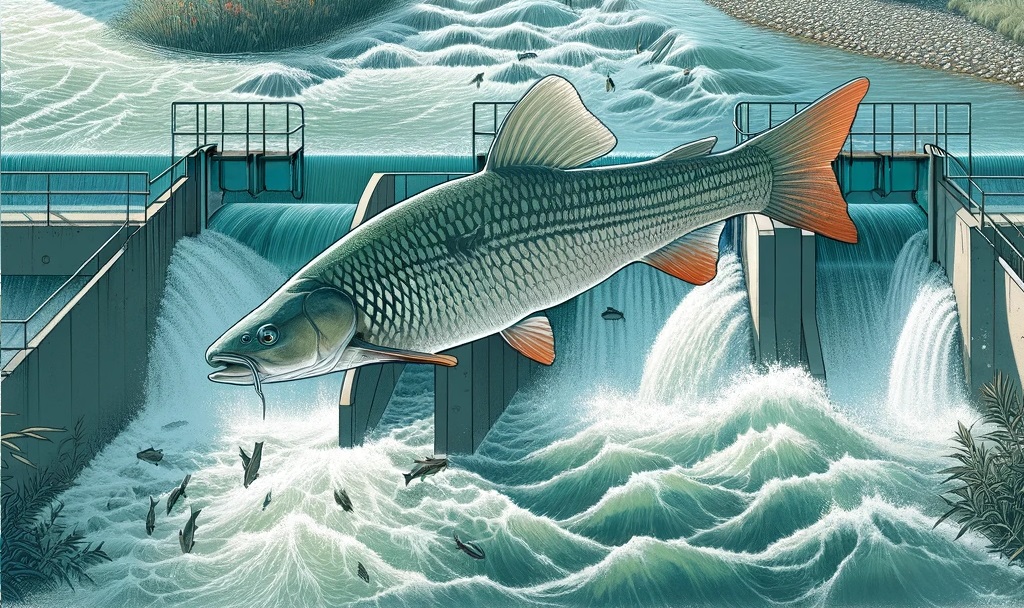
[Summary of the work] This research assesses the effectiveness of natural materials like cork, wood fibers, and rock mineral wool in enhancing beehive insulation. Addressing the need for better bee wellbeing and productivity during hotter summers, the study integrates the use of cost-effective sensor networks to monitor hive conditions. These sensors help evaluate the thermal performance of natural insulators, highlighting their compatibility with organic beekeeping and contrasting with synthetic materials. The results show these eco-friendly materials maintain stable internal hive temperatures and humidity, demonstrating their potential in improving hive environments for healthier, more productive bees.
Casado, M., Prado-Jimeno, R., & Fuentes-Pérez, J. F.* (2024). Comparative study of natural fibres to improve insulation in wooden beehives using sensor networks. Unde review.
Casado, M., Prado-Jimeno, R., & Fuentes-Pérez, J. F.* (2024). Comparative study of natural fibres to improve insulation in wooden beehives using sensor networks. Unde review.
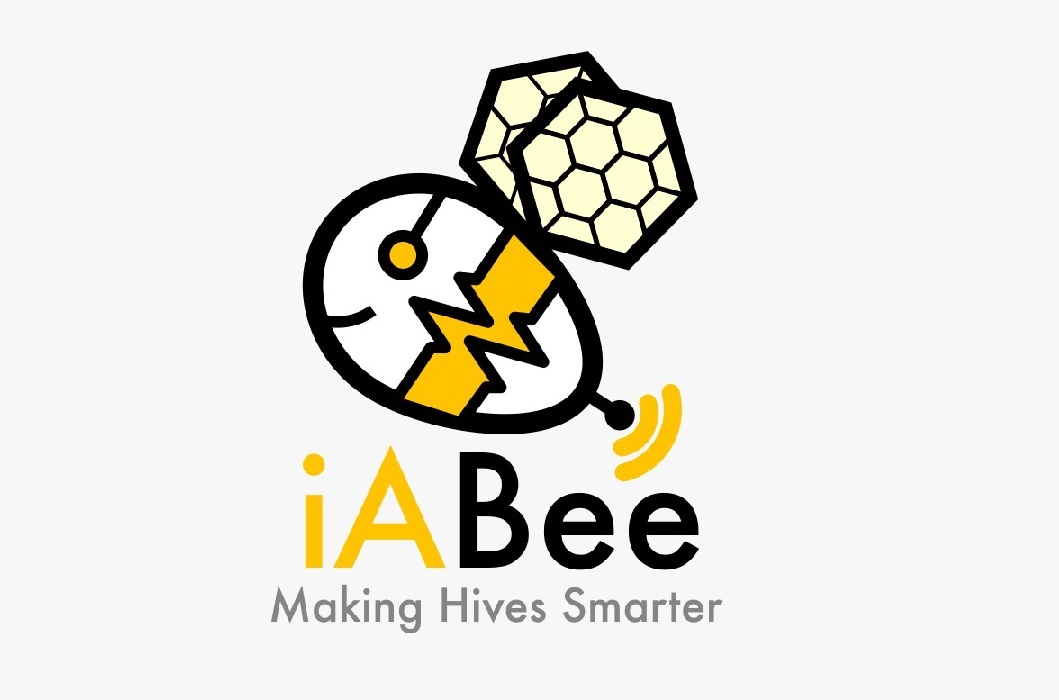
[Summary of the work]
This study examines the impact of human-made river barriers on biodiversity, focusing on the role of Vertical Slot Fishways (VSFs) in mitigating fish biodiversity loss. It compares the effectiveness of three-dimensional (3D RANS) and two-dimensional (2D SWE) hydrodynamic simulations in an agent-based model of fish movement through VSFs. The research found that while both models were successful in predicting fish movement, the 2D simulations might overestimate certain hydrodynamic variables, potentially leading to biases in understanding fish behavior. Despite this, the study validates the use of both simulation types in designing fishways, with a caution about the limitations of the 2D model in accurately reflecting real fish responses.
Ruiz-Coello, M. X., Fuentes-Pérez, J. F.*, Sanz-Ronda, F. J., Marion, A., & Bottacin-Busolin, A. (2024). Suitability of 2D depth-averaged simulations to support predictions of cyprinids passage through Vertical Slot Fishways. Unde review.
Ruiz-Coello, M. X., Fuentes-Pérez, J. F.*, Sanz-Ronda, F. J., Marion, A., & Bottacin-Busolin, A. (2024). Suitability of 2D depth-averaged simulations to support predictions of cyprinids passage through Vertical Slot Fishways. Unde review.
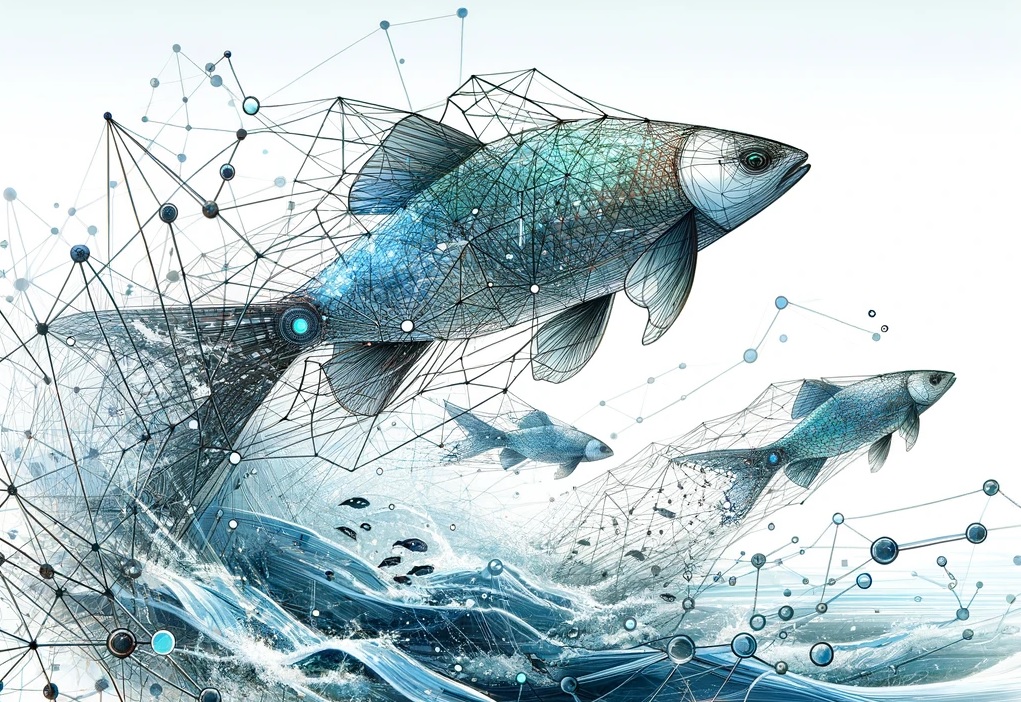
[Summary of the work] "Escalas" is an innovative tool designed to improve stepped fishways for fish migration, integrating civil engineering and biology. It aids in the design, simulation, assessment, and modification of fishways, adaptable to various hydraulic conditions. The tool's modular design allows for flexible configurations and caters to the specific needs of fish. By applying engineering informatics, Escalas enhances decision-making in fishway design, incorporating the latest research advancements. This advancement is crucial for efficient fishway engineering, ensuring better adaptability to different river scenarios.
Fuentes-Pérez, J. F., García-Vega, A., Martínez de Azagra Paredes, A., & Sanz-Ronda, F. J. (2024). A step forward in fishway engineering: validation and implementation of advanced algorithms for effective stepped fishway design, modeling, and retrofitting. Heliyon, 2024, e25996. DOI: 10.1016/j.heliyon.2024.e25996
Fuentes-Pérez, J. F., García-Vega, A., Martínez de Azagra Paredes, A., & Sanz-Ronda, F. J. (2024). A step forward in fishway engineering: validation and implementation of advanced algorithms for effective stepped fishway design, modeling, and retrofitting. Heliyon, 2024, e25996. DOI: 10.1016/j.heliyon.2024.e25996
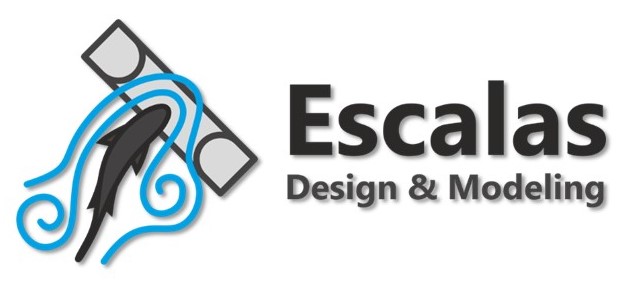
Most freshwater fish need to move freely through rivers to complete their life cycles. Thus, river barriers may delay, hinder or even block their longitudinal movements, affecting fish conservation. The most widespread solution to allow upstream fish migration are fishways, whereas downstream migration is basically facilitated through spillways, turbines or specific solutions such as bypass systems. So far, studies and scientific discussions concerning bidirectional movements through fishways are scarce and focused on large dams and reservoirs, mainly with large migratory species such as salmonids, rather than smaller facilities and lesser known species. This study investigated bidirectional movements through a small run-of-the-river hydropower plant with a pool-and-orifice type fishway, using the Iberian barbel (Luciobarbus bocagei), a potamodromous cyprinid, as the target species. Passive integrated transponder and radio tracking data were collected over 4 years and combined to characterize upstream and downstream movements. The results show diverse fish movements with inter- and intra-annual variability, with several individuals performing bidirectional movements and even some fish returning over the years. The documented movements and observations indicate that fishways can serve as an effective bidirectional migration corridor for fish, potentially enhancing the conservation efforts for potamodromous species. This study supports the decision to use fishways as an overall mitigation tool to reduce the impact of small hydropower facilities on fish.
Bravo-Córdoba, F. J., García-Vega,A. , Fuentes-Pérez, J. F., Fernandes-Celestino, L., Makrakis, S. & Sanz-Ronda, F. J. (2023). Bidirectional connectivity on step-pool fishways: Analyzing the case of small hydropower plants. Aquatic Conserv: Mar Freshw Ecosyst. 2023;33:549–565. DOI: 10.1002/aqc.3950
Bravo-Córdoba, F. J., García-Vega,A. , Fuentes-Pérez, J. F., Fernandes-Celestino, L., Makrakis, S. & Sanz-Ronda, F. J. (2023). Bidirectional connectivity on step-pool fishways: Analyzing the case of small hydropower plants. Aquatic Conserv: Mar Freshw Ecosyst. 2023;33:549–565. DOI: 10.1002/aqc.3950
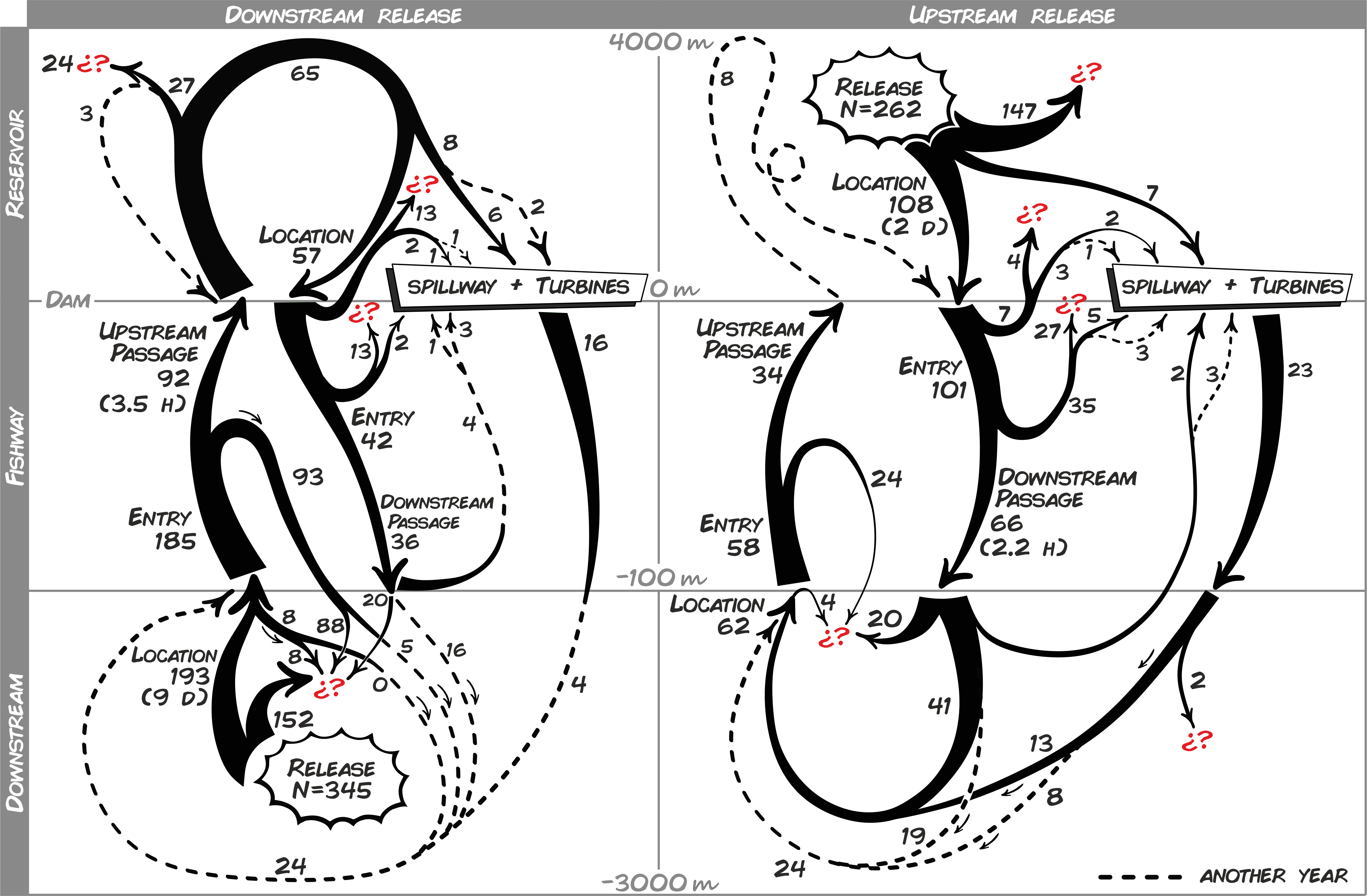
Hydropower globally represents the main source of renewable energy, and provides several benefits, e.g., water storage and flexibility; on the other hand, it may cause significant impacts on the environment. Hence sustainable hydropower needs to achieve a balance between electricity generation, impacts on ecosystems and benefits on society, supporting the achievement of the Green Deal targets. The implementation of digital, information, communication and control (DICC) technologies is emerging as an effective strategy to support such a trade-off, especially in the European Union (EU), fostering both the green and the digital transitions. In this study, we show how DICC can foster the environmental integration of hydropower into the Earth spheres, with focus on the hydrosphere (e.g., on water quality and quantity, hydropeaking mitigation, environmental flow control), biosphere (e.g., improvement of riparian vegetation, fish habitat and migration), atmosphere (reduction of methane emissions and evaporation from reservoirs), lithosphere (better sediment management, reduction of seepages), and on the anthroposphere (e.g., reduction of pollution associated to combined sewer overflows, chemicals, plastics and microplastics). With reference to the abovementioned Earth spheres, the main DICC applications, case studies, challenges, Technology Readiness Level, benefits and limitations, and transversal benefits for energy generation and predictive Operation and Maintenance, are discussed.
Quaranta, E., Bejarano, M. D., Comoglio, C., Fuentes-Pérez, J. F., Pérez-Díaz, J. I., Sanz-Ronda, F. J., ... & Tuhtan, J. A. (2023). Digitalization and real-time control to mitigate environmental impacts of artificial barriers in rivers: Focus on hydropower systems and European priorities. Science of The Total Environment, 162489. DOI: 10.1016/j.scitotenv.2023.162489
Quaranta, E., Bejarano, M. D., Comoglio, C., Fuentes-Pérez, J. F., Pérez-Díaz, J. I., Sanz-Ronda, F. J., ... & Tuhtan, J. A. (2023). Digitalization and real-time control to mitigate environmental impacts of artificial barriers in rivers: Focus on hydropower systems and European priorities. Science of The Total Environment, 162489. DOI: 10.1016/j.scitotenv.2023.162489
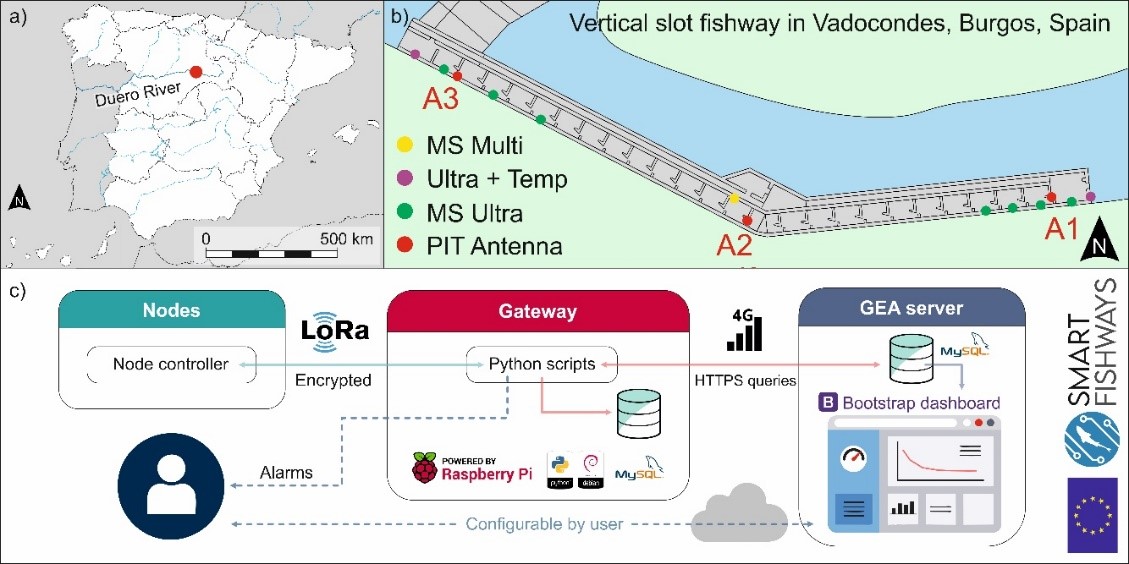
Water temperature and flow velocity directly affect the fish swimming capacity, and thus, both variables influence the fish passage through river barriers. Nonetheless, their effects are usually disregarded in fishway engineering and management. This study aims to evaluate the volitional swimming capacity of the northern straight-mouth nase (Pseudochondrostoma duriense), considering the possible effects of water temperature, flow velocity and body size. For this, the maximum distance, swim speed and fatigue time (FT) were studied in an outdoor open-channel flume in the Duero River (Burgos, Spain) against three nominal velocities and temperatures , also including the changes between swimming modes (prolonged and sprint). The provided information goes a step forward in the definition of real fish swimming capacities, and in turn, will contribute to establish clear passage criteria for thermo-velocity barriers, allowing the calculation of the proportion of fish able to pass a barrier under different working scenarios, as well designing of the optimized solutions to improve the fish passage through river barriers
García-Vega, A., Ruiz-Legazpi, J., Fuentes-Pérez, J. F., Bravo-Córdoba, F. J., & Sanz-Ronda, F. J. (2023). Effect of thermo‐velocity barriers on fish: influence of water temperature, flow velocity and body size on the volitional swimming capacity of northern straight-mouth nase (Pseudochondrostoma duriense). Journal of Fish Biology. DOI: 10.1111/jfb.15310
García-Vega, A., Ruiz-Legazpi, J., Fuentes-Pérez, J. F., Bravo-Córdoba, F. J., & Sanz-Ronda, F. J. (2023). Effect of thermo‐velocity barriers on fish: influence of water temperature, flow velocity and body size on the volitional swimming capacity of northern straight-mouth nase (Pseudochondrostoma duriense). Journal of Fish Biology. DOI: 10.1111/jfb.15310
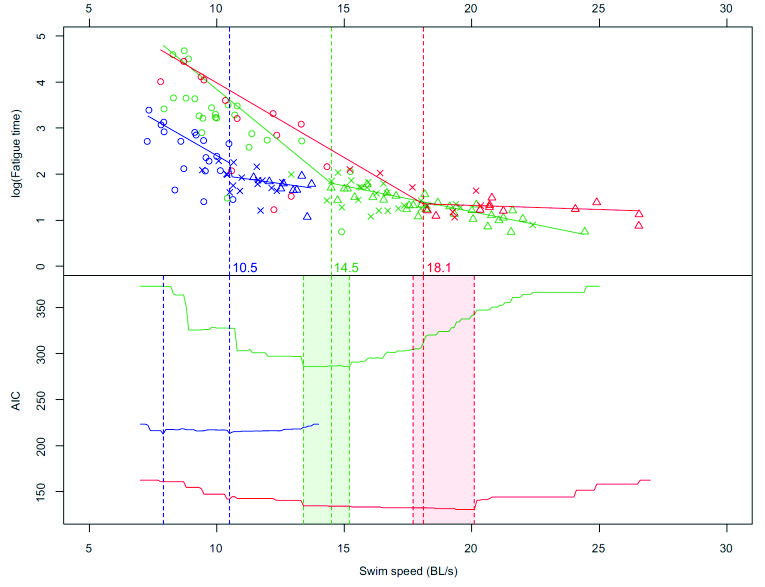
Hydrological variability can alter the flow structures of fish passes. To determine if these conditions are within the physical capabilities of fish, it is necessary to measure the hydraulic conditions under different scenarios. Drifters have the potential to facilitate these measurements at a fraction of the cost of traditional monitoring methods. These floating objects are equipped with sensors that can passively follow the movements of water, collecting and transmitting information about their movement and the surrounding environment. In this paper, we present and assess a low-cost, customizable drifter developed with off-the-shelf components. One of the main goals of this work is to establish an open hardware and software foundation to increase the use of drifters in river and fishway studies.
Fuentes-Pérez, J. F., Sanz-Ronda, F. J., & Tuhtan, J. A. (2022). An Open Surface Drifter for River Flow Field Characterization. Sensors, 22(24), 9918. DOI: 10.3390/s22249918
Fuentes-Pérez, J. F., Sanz-Ronda, F. J., & Tuhtan, J. A. (2022). An Open Surface Drifter for River Flow Field Characterization. Sensors, 22(24), 9918. DOI: 10.3390/s22249918
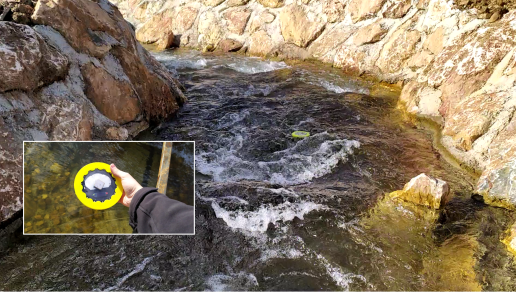
To assess the effect of hydrological variability on fishways it is necessary to stablish the passage limits of fish. In this paper we show how under specific circustances fish are able to surpass the design recomendations of fishways. To do so, assess brown trout (Salmo trutta) passage through a free-flow pool-weir-type fishway with hydrodynamic notches and extreme water drops between pools. The initial hypothesis, considering the fishway design and assessment guidelines, classified this structure as hardly insurmountable. Results showed an ascent success of 19% with a median transit time of 29.1 min/m of ascended height. Larger fish and fishway sections with lower values of volumetric power dissipation were related to a better performance in the passage.
Bravo-Córdoba, F. J., Fuentes-Pérez, J. F., García-Vega, A., Peñas, F. J., Barquín, J., & Sanz-Ronda, F. J. (2022). Brown Trout Upstream Passage Performance for a Fishway with Water Drops between Pools beyond Fish Passage Design Recommendations. Water, 14(17), 2750. DOI: 10.3390/w14172750
Bravo-Córdoba, F. J., Fuentes-Pérez, J. F., García-Vega, A., Peñas, F. J., Barquín, J., & Sanz-Ronda, F. J. (2022). Brown Trout Upstream Passage Performance for a Fishway with Water Drops between Pools beyond Fish Passage Design Recommendations. Water, 14(17), 2750. DOI: 10.3390/w14172750

Hydrological variability not only affects the passage through fishways but also influences the permeability of obstacles. In this paper, we explore the possible impact of flat-V gauging stations to fish passage and migration. For this, radio-tracking and video monitoring observations were combined with computational fluid dynamics (CFD) models and sensor data in two flat-V weirs, using Iberian barbel (Luciobarbus bocagei) as target species. Results show that fish passage is conditioned by both hydraulic and behavioral processes, providing evidences about the hydrological scenarios where flat-V weirs may act as full or partial barriers to upstream movements. These findings are of interest to quantify flat-V weir impacts, for engineering applications and to establish managing or retrofitting actions when required.
Sanz-Ronda, F. J., Bravo-Córdoba, F. J., García-Vega, A.,Valbuena-Castro, J., Martínez de Azagra-Paredes, A., & Fuentes-Pérez, J. F. (2021). Fish Upstream Passage Through Gauging Stations. Experiences With Iberian Barbel in Flat-V Weirs. Fhises 2021, 6, 81. DOI: 10.3390/fishes6040081
Sanz-Ronda, F. J., Bravo-Córdoba, F. J., García-Vega, A.,Valbuena-Castro, J., Martínez de Azagra-Paredes, A., & Fuentes-Pérez, J. F. (2021). Fish Upstream Passage Through Gauging Stations. Experiences With Iberian Barbel in Flat-V Weirs. Fhises 2021, 6, 81. DOI: 10.3390/fishes6040081
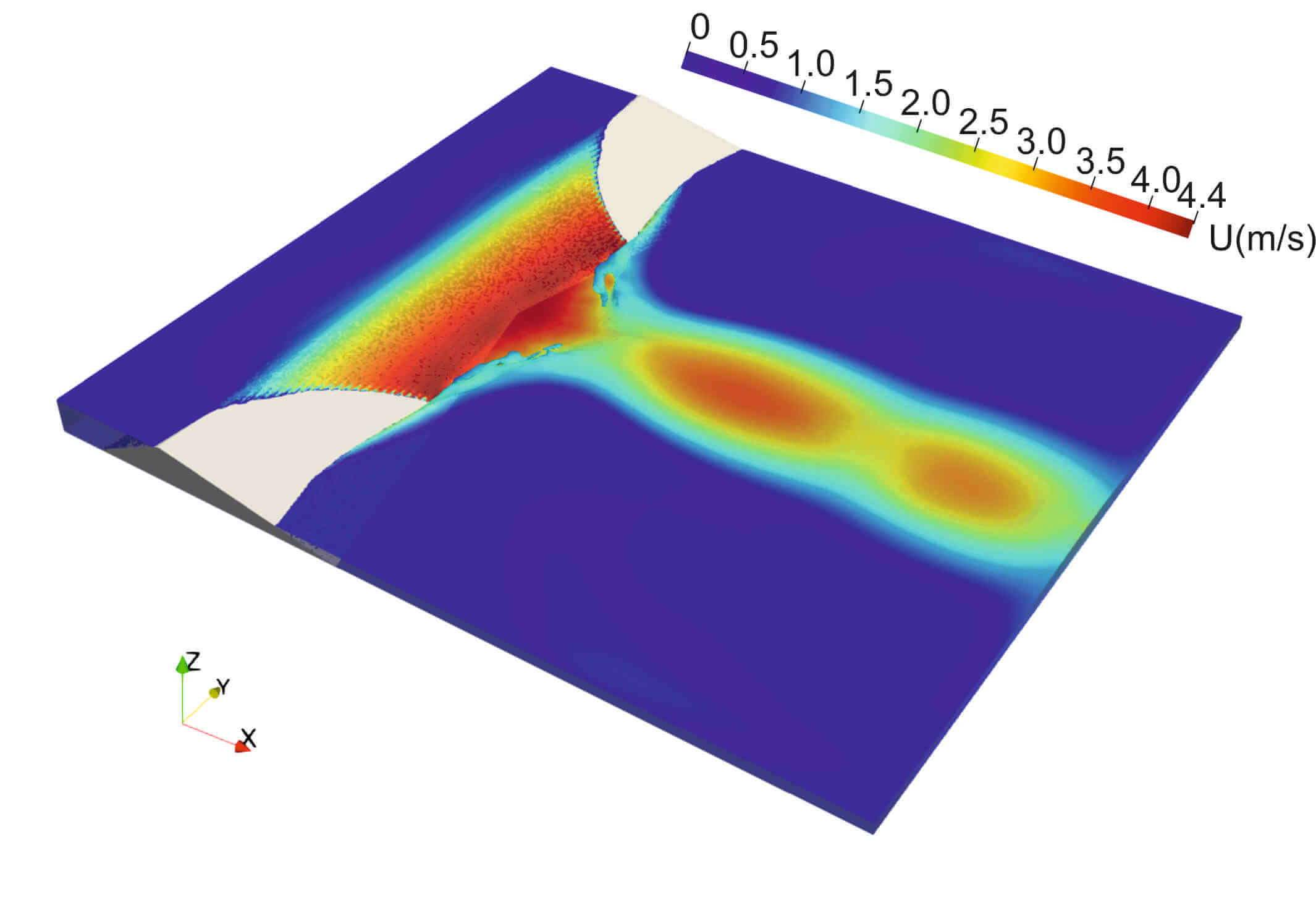
This paper explores the use of hydraulic monitoring on fishways to detect the need for maintenance in stepped fishways. For this, a novel low-cost sensor network that encapsulates fishways hydraulics in a neural network is developed, generating the first autonomous obstruction/malfunction detection system for stepped fishways. The system is based on a network of custom-made ultrasonic water level nodes that transmit data and alarms remotely and in real-time. Its performance was assessed in a field study case as well as offline, considering the influence of the number of sensing nodes and obstruction dimensions. Results show that the proposed system can detect malfunctions and that allows monitoring of the hydraulic performance of the fishway. Consequently, it optimizes the timing of maintenance on fishways and, thus, has the potential of automatizing and reducing the cost of these operations as well as augmenting the service of these structures. Therefore, this novel tool is a step forward to achieve smart fishway management and to increase their operability.
Fuentes-Pérez, J. F.,García-Vega, A., Bravo-Córdoba, F. J., & Sanz-Ronda, F. J. (2021). A Step to Smart Fishways: An Autonomous Obstruction Detection System Using Hydraulic Modeling and Sensor Networks. Sensors 2021, 21(20), 6909. DOI: 10.3390/s21206909
Fuentes-Pérez, J. F.,García-Vega, A., Bravo-Córdoba, F. J., & Sanz-Ronda, F. J. (2021). A Step to Smart Fishways: An Autonomous Obstruction Detection System Using Hydraulic Modeling and Sensor Networks. Sensors 2021, 21(20), 6909. DOI: 10.3390/s21206909
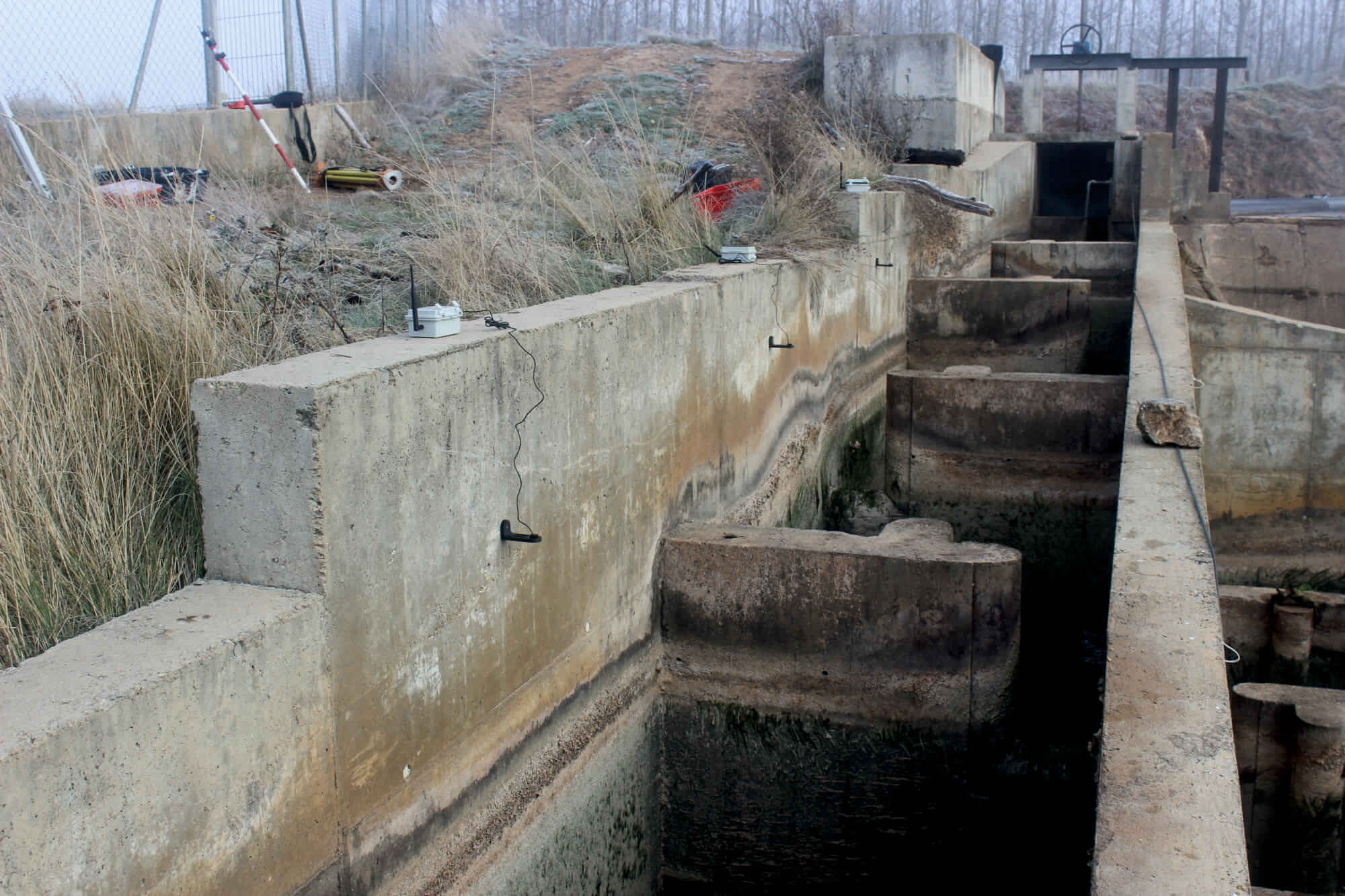
Conferences
Fuentes-Pérez, J. F.,García-Vega, A., Bravo-Córdoba, F. J., & Sanz-Ronda, F. J. (2023). Impulsando el manejo adaptativo a traves de la monitorización ambiental 4.0: La red ensorial Smart Fishways. IV Cogreso ibérico de restauración fluvial RESTAURARÍOS. DOI: 10.5281/zenodo.10402557
Sanz-Ronda, F. J., Bravo-Córdoba, F. J., García-Vega, A., Fuentes-Pérez, J. F., & Martínez de Azagra Paredes, A. (2023). 25 años de pasos para peces en España: aciertos, errores y esperanzas. IV Cogreso ibérico de restauración fluvial RESTAURARÍOS. DOI: 10.5281/zenodo.10403704
García-Vega, A., Bravo-Córdoba, F. J., Fuentes-Pérez, J. F., & Sanz-Ronda, F. J. (2023). Manejo adaptativo de pasos para peces: hacia un enfoque holístico para su gestión . IV Cogreso ibérico de restauración fluvial RESTAURARÍOS. DOI: 10.5281/zenodo.10403729
Fuentes-Pérez, J. F.,García-Vega, A., Bravo-Córdoba, F. J., & Sanz-Ronda, F. J. (2023). Real-time monitoring of fishway performance using a customizable sensor network architecture. XVII Young Researchers Meeting on Conservation and Sustainable Use of Forest Systems. DOI: 10.5281/zenodo.7780604
Fuentes-Pérez, J. F.,García-Vega, A., Bravo-Córdoba, F. J., & Sanz-Ronda, F. J. (2022). Smart fishways: real-time sensorization of fishways for autonomous assessment and management of their performance. The 2022 International Symposium on Ecohydraulics. DOI: 10.5281/zenodo.7780532
Fuentes-Pérez, J. F.,García-Vega, A., Bravo-Córdoba, F. J., & Sanz-Ronda, F. J. (2021). Smart Fishways: A Sensor Network for the Assessment of Fishway Performance. SIBIC 2022. Published in Biology and Life Sciences Forum (Vol. 13, No. 1, p. 20). DOI: 10.3390/blsf2022013076
Public deliverables
WP0: Data Management
WP1: WLN sensor network development
WP2: Installation of the WLN
WP3: Development of a fish counter and environmental variables logger
WP4: Smart Fishways
WP5: Dissemination and Explotation
WP6: Project Management
The Data Management Plan describes the data management life cycle for all data sets that will be collected, processed or generated by Smart Fishway. It is a document describing what data will be collected, processed or generated and following what methodology and standards, whether and how this data will be shared and/or made open, and how it will be curated and preserved. It is a living document that will be periodically updated.
Last update: 01.12.2021
Last update: 01.12.2021
The "Water level monitoring sensor network" deliverable contains a detailed description of the developed sensor network to capture the hydraulic behaviour of stepped fishways to assess their performance under different hydrological scenarios.
Uploaded: 01.12.2021
Uploaded: 01.12.2021
The 'Field Study Cases and Installation' deliverable offers a detailed description of the various study cases examined during the Smart Fishways project, with special emphasis on those installations considered permanent within the project. Additional information on the architecture of the installed networks is also provided.
Uploaded: 28.07.2022
Uploaded: 28.07.2022
The deliverable titled "Environmental Variable Logger Technical Report and User Guide" provides a comprehensive description of the developed environmental variable node, along with a user guide. This resource aims to facilitate the expansion of environmental variables recorded at each study case of Smart Fishways, thereby enhancing the monitoring and analysis capabilities of the system.
Uploaded: 17.07.2023
Uploaded: 17.07.2023
This deliverable of "Webpage, social media, dissemination and exploitation" contains a detailed description of the webpage architecture, which is a window for the general audience and stakeholders, as well as, a server to storage and real-time visualization of all collected data in the field and main outcomes of the project.
In addition, this and successive deliverables of the WP5 summarize all the social media interactions and dissemination activities.
Uploaded: 18.01.2024
In addition, this and successive deliverables of the WP5 summarize all the social media interactions and dissemination activities.
Uploaded: 18.01.2024